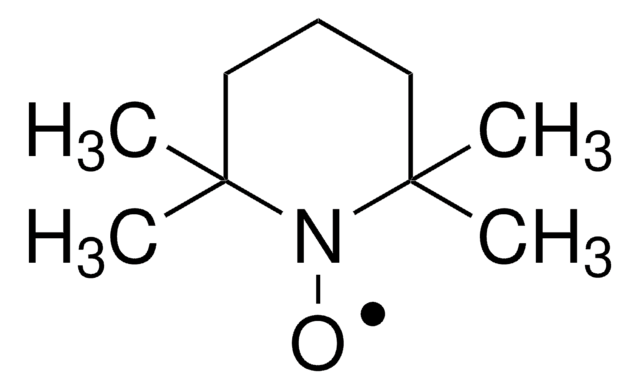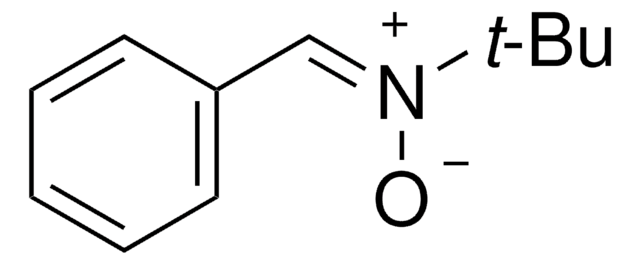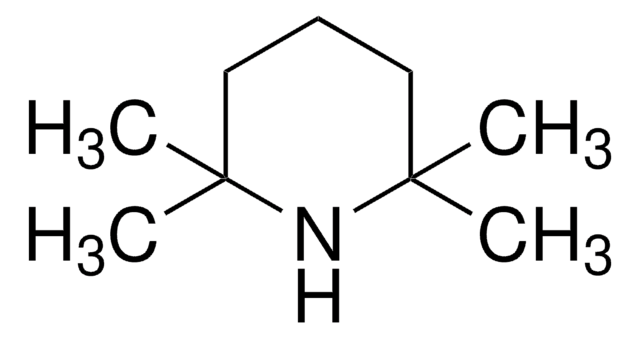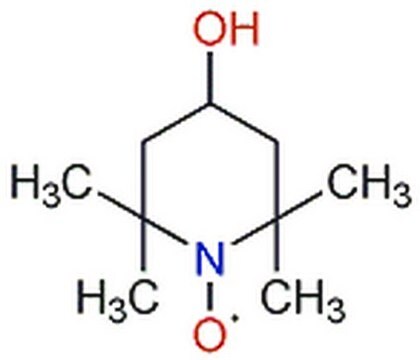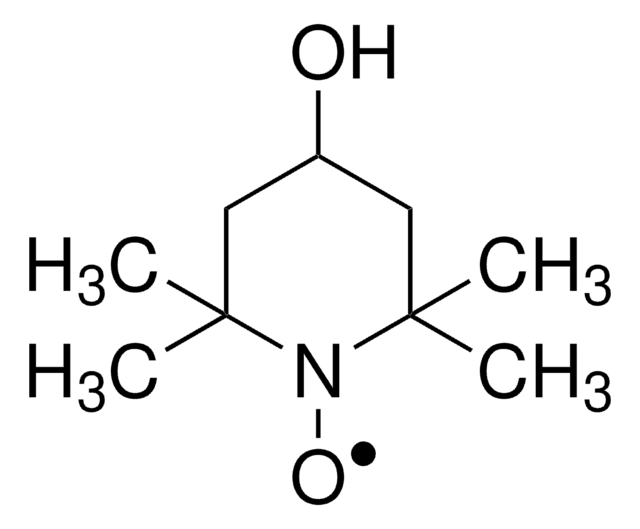92688
5,5-Dimethyl-1-pyrroline N-oxide
for ESR-spectroscopy
Sinonimo/i:
DMPO
Autenticatiper visualizzare i prezzi riservati alla tua organizzazione & contrattuali
About This Item
Formula empirica (notazione di Hill):
C6H11NO
Numero CAS:
Peso molecolare:
113.16
Beilstein:
107603
Numero CE:
Numero MDL:
Codice UNSPSC:
12000000
ID PubChem:
NACRES:
NA.21
Prodotti consigliati
Grado
for ESR-spectroscopy
Livello qualitativo
Saggio
≥98.0% (GC)
Stato
crystals
Indice di rifrazione
n20/D 1.496 (lit.)
P. ebollizione
75 °C/0.4 mmHg (lit.)
Punto di fusione
25-29 °C (lit.)
Densità
1.015 g/mL at 25 °C (lit.)
Temperatura di conservazione
−20°C
Stringa SMILE
CC1(C)CCC=[N+]1[O-]
InChI
1S/C6H11NO/c1-6(2)4-3-5-7(6)8/h5H,3-4H2,1-2H3
VCUVETGKTILCLC-UHFFFAOYSA-N
Cerchi prodotti simili? Visita Guida al confronto tra prodotti
Categorie correlate
Applicazioni
5,5-Dimethyl-1-pyrroline N-oxide is a reagent generally used either as a free-radical spin-trapping agent, or electrophilic component during the synthesis of pyrrolidine derivatives. It may also be considered as 1,3-dipole in cycloaddition processes.
Neuroprotective agent; nitric oxide spin trap. Used to study radicals formed by enzymatic acetaldehyde oxidation. Incubation of lymphocytes with DMPO decreased DNA damage by NiCl2.
Confezionamento
Bottomless glass bottle. Contents are inside inserted fused cone.
Codice della classe di stoccaggio
11 - Combustible Solids
Classe di pericolosità dell'acqua (WGK)
WGK 3
Punto d’infiammabilità (°F)
203.0 °F - closed cup
Punto d’infiammabilità (°C)
95 °C - closed cup
Scegli una delle versioni più recenti:
Possiedi già questo prodotto?
I documenti relativi ai prodotti acquistati recentemente sono disponibili nell’Archivio dei documenti.
Karim Michail et al.
Analytical chemistry, 84(15), 6739-6746 (2012-06-26)
Free radicals are conventionally detected by electron paramagnetic resonance (EPR) spectroscopy after being trapped as spin adducts. Albeit this technique has demonstrated utmost efficacy in studying free radicals, its application to biological settings is intrinsically hampered by the inevitable bioreduction
Murugesan Velayutham et al.
Free radical biology & medicine, 51(1), 160-170 (2011-05-07)
In cells, mitochondria, endoplasmic reticulum, and peroxisomes are the major sources of reactive oxygen species (ROS) under physiological and pathophysiological conditions. Cytochrome c (cyt c) is known to participate in mitochondrial electron transport and has antioxidant and peroxidase activities. Under
Pedro L Zamora et al.
The journal of physical chemistry. A, 116(26), 7210-7218 (2012-06-07)
Radical forms of sulfur dioxide (SO(2)), sulfite (SO(3)(2-)), sulfate (SO(4)(2-)), and their conjugate acids are known to be generated in vivo through various chemical and biochemical pathways. Oxides of sulfur are environmentally pervasive compounds and are associated with a number
Emiko Sato et al.
Journal of biochemistry, 150(2), 173-181 (2011-05-17)
The nicotinamide adenine dinucleotide (NADH)/nicotinamide adenine dinucleotide phosphate (NADPH) oxidase and the xanthine oxidase (XOD) systems generate reactive oxygen species (ROS). In the present study, to characterize the difference between the two systems, the kinetics of ROS generated by both
Suchandra Bhattacharjee et al.
Nucleic acids research, 40(12), 5477-5486 (2012-03-06)
Oxidative stress-related damage to the DNA macromolecule produces lesions that are implicated in various diseases. To understand damage to DNA, it is important to study the free radical reactions causing the damage. Measurement of DNA damage has been a matter
Il team dei nostri ricercatori vanta grande esperienza in tutte le aree della ricerca quali Life Science, scienza dei materiali, sintesi chimica, cromatografia, discipline analitiche, ecc..
Contatta l'Assistenza Tecnica.